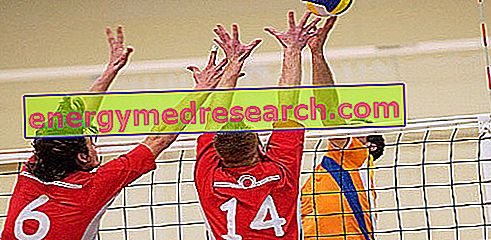The wall is the natural response of opposition that the network players put in place as a result of the opponent's attack.
Wall technique. The wall consists of a jump which is combined with the raising of the arms stretched upwards, so as to form, with the hands, a plane repulsed by the ball towards the opposing field.
The execution of the wall is divided into four phases:
1) starting position
2) loading
3) extension
4) relapse
Starting position
The legs must be slightly bent, ready to detach
The distance from the mains must be about 50cm
The arms are high and with the elbows in front of the face
The hands lie above the height of the head and the fingers are well open
The feet must be parallel, otherwise the push upwards will result in a push up - forward!
Loading
What characterizes the loading is the closing of the tibio-tarsal angle, that is the one between the leg and the foot.
Extension
It is very important to extend the upper limbs directly high-forward looking for a good intrusiveness.
relapse
The legs must cushion the relapse with a slight bending; the feet must touch the ground more or less simultaneously and in good balance. In relapse, the arms must delay the return back as much as possible, both to help maintain a good balance and to prolong the effectiveness of the wall.

KEY POINTS FOR THE BEST SUCCESS OF THE INDIVIDUAL WALL
(Source: Vieira - Ferguson - VOLLEYBALL - Basic education manual for coaches and players - Publisher: CALZETTI MARIUCCI)
Preparation
1-Focus on the lifter
2-Focus on the hunter after raising
3-Place the body on the crushing side of the spiker
4-Keep the waiting position with your hands at shoulder height
5-Spread your fingers well
6-After the lifter's touch, bend the knees and raise the hands
7-Maintain the high position during exhaustion
execution
1-Jump after the spiker has jumped
2-Penetrate with your hands in the opposing field
3-Pull back the hands
4-Return to the ground
5-Land with both feet
continuation
1-Bend the knees to cushion the descent
2-Move away from the net
3-Watch the ball
4-Return to the original position
5 - Prepare for the next action
Edited by: Lorenzo Boscariol
Bibliography



